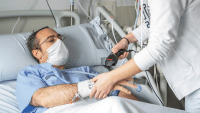This Magnet®-recognized organization created a process for virtual bedside transfers.
Takeaways:
- Virtual patient handoffs using web-enabled devices can reduce anxiety for both nurses and patients.
- Mobile technology can be used securely in healthcare.
Evidence suggests that bedside handoff reporting improves patient safety, reduces medical errors, contributes to patient and staff satisfaction, and fosters teamwork and empowerment. Although handoff communication between nurses in two separate units has been traditionally done over the phone, current technology opens a window of opportunity for a handoff in a virtual environment through a secured mobile device that’s compliant with the Health Insurance Portability and Accountability Act (HIPAA), using a web-based application with video conferencing capability. This technology provides real-time, face-to-face transfer of information and promotes accountability between the receiving and transferring nurse, almost as if they were together at the patient’s bedside.
The research
At The University of Texas Medical Branch, a Magnet®-recognized facility, we used our evidence-based practice (EBP) model, called Disciplined Clinical Inquiry, to uncover and translate the best evidence in our practice setting. We formed a team composed of a clinical expert, nurse manager, and bedside clinicians. Our search of standard databases didn’t turn up any studies that focused on using mobile devices during unit-to-unit patient handoffs. Our online search, however, uncovered a study by a university teaching hospital in the northeastern United States exploring the effects of using a mobile device during patient handoffs between the postanesthesia care and orthopedic units. The transferring nurse and the receiving nurse used their iPads’ Facetime application.
The test
Based on the integration of the best available evidence, we designed a 3-month rapid cycle system prototype using web-enabled technology to improve patient and nurse satisfaction during cross-unit transfer of care from one nurse to another. Our Information Services Department configured two WiFi-enabled tablets and installed a secure, HIPAA-compliant application with video conferencing capability. All preinstalled table applications were deactivated, and security software was installed during configuration.
Before the patient’s physical transfer to another unit, the transferring and receiving nurses activated their respective tablets for the verbal report of the patient handoff. After completing the verbal report, the transferring nurse took the tablet to the patient’s room for a face-to-face interaction between the receiving nurse, patient, and family. At this point, the receiving nurse has an opportunity to make a quick, head-to-toe assessment of the patient. Throughout the virtual interaction, the patient and family were encouraged to ask questions about the plan of care. The video call was concluded after all pertinent issues were discussed and appropriately addressed.
The evaluation
We evaluated our initiative using a presdischarge patient opinion survey, focusing on the patient’s experience during the virtual handoff. Fifty percent of the patients (n = 10) who responded to the survey reported that the virtual interaction reduced their level of anxiety about the transfer to a new care environment, 70% indicated that the virtual interaction with the nurse felt like real face-to-face contact, and 70% noted that the nurses worked as a team across the hospital.
We also conducted a nurse satisfaction survey. Seventy-five percent of the nurses who participated (n = 18) reported that the virtual handoff helped confirm the verbal report given by the transferring nurse, and 72% indicated that this form of patient handoff helped them better anticipate their patient’s needs. The nurses indicated that face-to-face interaction with their patients gave them the opportunity to introduce themselves and establish a rapport.
The challenges
The virtual handoff introduced change into the nurses’ routines, so we encountered some resistance. Although only a few admitted it during the planning phase, some nurses claimed lack of competence using the tablets to make video calls. During the early part of the initiative, we also encountered problems with the WiFi connection and technical difficulties with the tablets themselves because of the new configuration. In a few situations, patients weren’t able to participate during the handoffs because they were either in pain or mildly sedated.
The cost to purchase two 16 gigabyte, WiFi enabled tablets was $866 ($433 per tablet). Our information services department charged a configuration fee of $200 ($100 per tablet), and our unit pays $13.13 per tablet each month for technical support provided by our information services department.
The final analysis
On the whole, we received positive feedback from patients and nurses. The active engagement of our nurse manager facilitated coverage of the technology cost and helped sustain nurse participation in practice change, a key element in Magnet recognition.
As a result of our EBP-disciplined clinical inquiry initiative, our intermediate specialty care unit and the surgical intensive unit together decided to conduct all patient handoffs using their mobile devices. Six months later, this initiative was expanded to the multispecialty surgical and post anesthesia care units. Our ultimate goal is hospital-wide use of mobile devices during patient handoffs.
Both authors work at the University of Texas Medical Branch in Galveston. Dennis Santa is a patient care facilitator in the intermediate specialty care unit, and Dell E. Roach is the nurse manager of the surgical intensive care and intermediate specialty care units.
Selected references
Gregory S, Tan D, Tilrico M, Edwardson N, Gamm L. Bedside shift reports: What does the evidence say? J Nurs Adm. 2014;44(10):541-5.
Jeffs L, Acott A, Simpson E, et al. The value of bedside shift reporting enhancing nurse surveillance, accountability, and patient safety. J Nurs Care Qual. 2013;28(3):226-32.
Ofori-Atta J, Binienda M, Chalupka S. Bedside shift report: Implications for safety and quality of care. Nursing. 2015;45(8):1-4.
Sanares-Carreon D. From caterpillars to butterflies: Engaging nurse leaders in evidence-based practice reform. Nurs Adm Q. 2016;40(2):173-81.


















